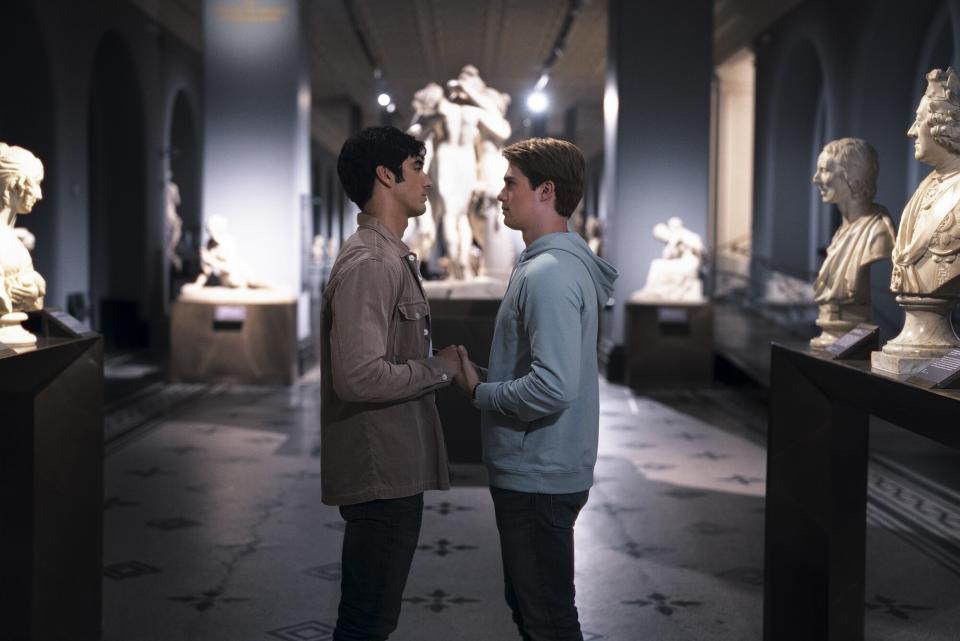How Red, White & Royal Blue landed the Victoria and Albert Museum for a swoony scene
Warning: This article contains spoilers about Red, White & Royal Blue.
We love a royal romance with historical implications — and while Prince Henry (Nicholas Galitzine) and Alex Claremon-Diaz's (Taylor Zakhar Perez) love story is a cultural game-changer, it also takes place amidst literal pieces of history in a key scene of Red, White & Royal Blue, now on Prime Video.
When Alex goes to see Henry in England, the prince takes him to London's Victoria and Albert Museum after hours, where the two slow dance in a gallery filled with statues. And that's the actual museum on screen (filmed after hours very early in the morning), translated directly from Casey McQuiston's bestselling novel.
For Galitzine, who grew up going to the museum, it was a surreal experience. "I was born and raised in London and the V&A is an iconic place to visit — the galleries, the displays, exhibitions that have been on there. To be able to witness it in such a quiet state was really bizarre. Night shoots are disorienting at the best of times. It's 5:00 in the morning, you're trying to act and be emotional, and you're in this truly beautiful, picturesque setting. It was really cool to be able to explore it. It felt a bit like Night in the Museum. It was a weird, surreal but extremely enjoyable experience."

Jonathan Prime/Prime Video Taylor Zakhar Perez and Nicholas Galitzine in 'Red, White & Royal Blue'
But it wasn't as simple as booking some early morning time. Director Matthew López didn't know for much of the pre-production process whether the V&A would even allow them to film there. "They were very, very protective as you could imagine," he tells EW. " Especially when we told them where we wanted to shoot, which is a lot of things we could break, and I really didn't want to be the guy who ended up breaking a priceless piece of statuary. But we ended up getting permission, and that was amazing."
In McQuiston's novel, this key scene takes place in the Renaissance Gallery, which López and cinematographer Stephen Goldblatt visited while scouting in London. But while we still see Henry and Alex run through that gallery, they decided to choose another due to the V&A's filming parameters.
"It's not the most photogenic gallery," explains López. "It's kind of dark and it's very, very big, so there's a lot of blank space between the statues. The chances that you're going to get just a white wall behind you are good. And it's very hard to shoot in there because the rule that the V&A had for us was that we couldn't bring in any exterior lighting. We could not bring it in our own lights."
But Goldblatt had an idea to work around that limitation. "He led me to this area of the museum where we did end up filming it," the director continues. "That long, beautiful corridor with all those gorgeous statues filled with very homoerotic art, as well as that narrow alleyway of busts. We came back another night after closing, and he had them turn off everything, all the lights except for the spotlights that were there, illuminating the artwork. But turning off the floodlights that lit the gallery for people to walk around in. What you had in an instant was darkness everywhere and light shining on the art."
Goldblatt manipulated the light further with a dimmer switch, creating an almost sacred environment in which Henry and Alex could express their love for each other.
"We did not bring in any of our own lighting," emphasizes López. "That scene is shot with the lighting that's available to us at the V&A. We decided that the scene would be the boys for the most part in shadow and the statues illuminated. It was a beautiful use of a problem to create a better solution that you could not have come up with on your own if you had no problem."
Their loss of light is audiences' swoony gain.
Want more movie news? Sign up for Entertainment Weekly's free newsletter to get the latest trailers, celebrity interviews, film reviews, and more.
Related content:

